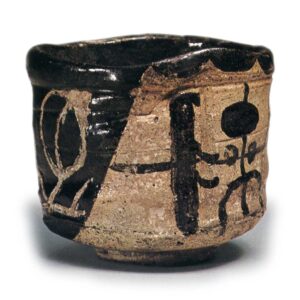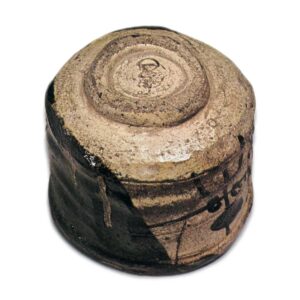

Height 9.5 cm, mouth diameter 10.5 cm, base diameter 5.3 cm
Tokugawa Art Museum
Among the numerous black Oribe tea bowls, this tea bowl is highly regarded as an outstanding one due to its unparalleled interestingness. It is a round cylindrical tea bowl, with a thick spatula on the bottom, and a thick wheel-thrown pattern around the waist. The base of the bowl is irregularly rounded and the tatami mat is slightly wide. The interior and two thirds of the exterior are glazed with a jet-black fused glaze, and the white-glazed areas are painted with abstract patterns in iron pigments and covered with a feldspar white glaze. The black glazed area is also covered with a white glaze with a large leaf-like pattern carved in lines, and the bottom is also covered with a white glaze, but the ashen-white clay is visible on the tatami mat of the base.
There is a mark like “2” stamped inside the base, but it is not clear whether this is a kiln mark or the owner’s hand stamp. However, there is an old saying that this mark was made by a person named Kozon. Since pottery shards of tea bowls with the same seal have been excavated from Muda-do and Ohira kilns in Oyaya and the Oyasan Omote Kiln in Kusiri, Fujio Koyama assumes that the person who made this tea bowl visited here and there to make it. However, in the same sense, this could also be interpreted as the mark of the person who ordered it.
On the back of the lid of the paulownia inner box, Ryōrōsai wrote “Wori-he tsutsu chawan, wintry withered,” which was once in the collection of the Okatani family in Nagoya, but was donated to the Tokugawa Art Museum.



